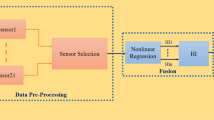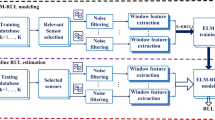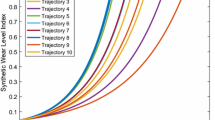Abstract
Degradation of systems is a natural and inevitable process which widely happens in industries. Therefore, prognostics is used to prevent unexpected failures of complex engineering systems by evaluating the health status of the system and estimating the remaining useful life, using multiple sensors that simultaneously monitor the degradation process of the system. Since these sensor signals often have usable and effective information about a degradation process, data fusion methods are used to obtain more precise and reliable prognostic results. In this paper, the problem of prognostic modeling and remaining useful life estimation of the turbofan engine is considered and a methodology is proposed using data-level and feature-level fusion approaches to better characterize the degradation process of the system. A degradation model for the engine fault is developed by combining a physics-based model and a Wiener process with positive drift. The maximum likelihood estimation method is used to estimate the unknown parameters of the model. Eventually, the remaining useful life is estimated for testing data of a case study involving the degradation of a turbofan engine, and the results are evaluated.






Similar content being viewed by others
References
B.R. Endurthi, Linearization and Health Estimation of a Turbofan Engine (Diss. Cleveland State University, Cleveland, 2004)
K. Liu, N.Z. Gebraeel, J. Shi, A data-level fusion model for developing composite health indices for degradation modeling and prognostic analysis. IEEE Trans. Autom. Sci. Eng. 10(3), 652–664 (2013)
X. Li, F. Duan, D. Mba, I. Bennett, Multidimensional prognostics for rotating machinery: a review. Adv. Mech. Eng. 9(2), 1687814016685004 (2017)
D.L. Hall, J. Llinas, An introduction to multisensor data fusion. Proc. IEEE 85(1), 6–23 (1997)
K. Liu, A. Chehade, C. Song, Optimize the signal quality of the composite health index via data fusion for degradation modeling and prognostic analysis. IEEE Trans. Autom. Sci. Eng. 14(3), 1504–1514 (2015)
A. Chehade, C. Song, K. Liu, A. Saxena, X. Zhang, A data-level fusion approach for degradation modeling and prognostic analysis under multiple failure modes. J. Quality Technol. 50(2), 150–165 (2018)
H. Yan, K. Liu, X. Zhang, J. Shi, Multiple sensor data fusion for degradation modeling and prognostics under multiple operational conditions. IEEE Trans. Reliab. 65(3), 1416–1426 (2016)
X. Xiong, H. Yang, N. Cheng, Q. Li, Remaining useful life prognostics of aircraft engines based on damage propagation modeling and data analysis, in 2015 8th International Symposium on Computational Intelligence and Design (ISCID), vol 2 (IEEE, 2015)
J. Shi, Y. Li, G. Wang, X. Li, Health index synthetization and remaining useful life estimation for turbofan engines based on run-to-failure datasets.”. Eksploatacja i Niezawodność 18, 4 (2016)
D. Feng, M. Xiao, Y. Liu, H. Song, Z. Yang, L. Zhang, A kernel principal component analysis–based degradation model and remaining useful life estimation for the turbofan engine. Adv. Mech. Eng. 8(5), 1687814016650169 (2016)
P. Baraldi, G. Bonfanti, E. Zio, Differential evolution-based multi-objective optimization for the definition of a health indicator for fault diagnostics and prognostics. Mech. Syst. Signal Process. 102, 382–400 (2018)
G. Chen, J. Chen, Y. Zi, J. Pan, W. Han, An unsupervised feature extraction method for nonlinear deterioration process of complex equipment under multi dimensional no-label signals. Sens. Actuat. A 269, 464–473 (2018)
J. Xu, Y. Wang, L. Xu, PHM-oriented integrated fusion prognostics for aircraft engines based on sensor data. IEEE Sens. J. 14(4), 1124–1132 (2013)
L. Yongxiang, S. Jianming, W. Gong, L. Xiaodong, A data-driven prognostics approach for RUL based on principle component and instance learning, in 2016 IEEE International Conference on Prognostics and Health Management (ICPHM) (IEEE, 2016)
C. Song, K. Liu, Statistical degradation modeling and prognostics of multiple sensor signals via data fusion: a composite health index approach. IISE Trans. 50(10), 853–867 (2018)
A. Saxena, K. Goebel, D. Simon, N. Eklund, Damage propagation modeling for aircraft engine run-to-failure simulation. in 2008 International Conference on Prognostics and Health Management (IEEE, 2008)
D.K. Frederick, J.A. DeCastro, J.S. Litt, User’s guide for the commercial modular aero-propulsion system simulation (C-MAPSS) (2007)
V. Atamuradov, K. Medjaher, P. Dersin, B. Lamoureux, N. Zerhouni, Prognostics and health management for maintenance practitioners-review, implementation and tools evaluation. Int. J. Progn. Health Manag. 8(060), 1–31 (2017)
B. Schölkopf, A. Smola, K.R. Müller, Nonlinear component analysis as a kernel eigenvalue problem. Neural Comput. 10(5), 1299–1319 (1998)
D.G. Chen, Y. Lio, H.K.T. Ng, T.R. Tsai (eds.), Statistical Modeling for Degradation Data (Springer, Berlin, 2017)
Z.S. Ye, M. Xie, Stochastic modelling and analysis of degradation for highly reliable products. Appl. Stoch. Models Bus. Ind. 31(1), 16–32 (2015)
G. Jin, D. Matthews, Y. Fan, Q. Liu, Physics of failure-based degradation modeling and lifetime prediction of the momentum wheel in a dynamic covariate environment. Eng. Fail. Anal. 28, 222–240 (2013)
H. Lim, B.J. Yum, Optimal design of accelerated degradation tests based on Wiener process models. J. Appl. Stat. 38(2), 309–325 (2011)
Author information
Authors and Affiliations
Corresponding author
Additional information
Publisher's Note
Springer Nature remains neutral with regard to jurisdictional claims in published maps and institutional affiliations.
Rights and permissions
About this article
Cite this article
Ghorbani, S., Salahshoor, K. Estimating Remaining Useful Life of Turbofan Engine Using Data-Level Fusion and Feature-Level Fusion. J Fail. Anal. and Preven. 20, 323–332 (2020). https://doi.org/10.1007/s11668-020-00832-x
Received:
Published:
Issue Date:
DOI: https://doi.org/10.1007/s11668-020-00832-x




